engine CITROEN RELAY 2019 Handbook (in English)
[x] Cancel search | Manufacturer: CITROEN, Model Year: 2019, Model line: RELAY, Model: CITROEN RELAY 2019Pages: 232, PDF Size: 8.21 MB
Page 21 of 232

19
Retrieving the service
information
To access the ser vice indicators at any time,
press the MODE button briefly.
Use the up/down arrows to see the scheduling
information and engine oil usage.
Press the MODE button again to return to the
various display menus.
Hold it down to return to the home page.Menu…
Choose…Allows you to…
Service Ser vice (Miles/Km before
service)Display the distance remaining
before the next ser vice.
Oil change (Miles/Km before
oil change) Display the distance remaining
before the next oil change.
For more information on Vehicle configuration , refer to the corresponding section.
1
Dashboard instruments
Page 22 of 232
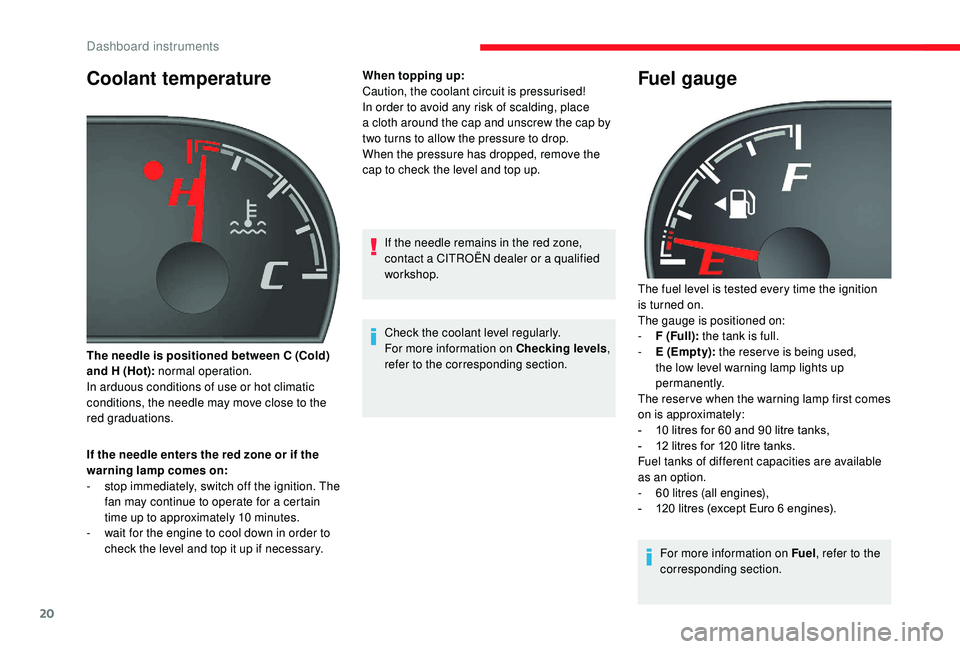
20
Coolant temperature
If the needle enters the red zone or if the
warning lamp comes on:
-
s
top immediately, switch off the ignition. The
fan may continue to operate for a
certain
time up to approximately 10
minutes.
-
w
ait for the engine to cool down in order to
check the level and top it up if necessary. When topping up:
Caution, the coolant circuit is pressurised!
In order to avoid any risk of scalding, place
a
cloth around the cap and unscrew the cap by
two turns to allow the pressure to drop.
When the pressure has dropped, remove the
cap to check the level and top up.
The needle is positioned between C (Cold)
and H (Hot): normal operation.
In arduous conditions of use or hot climatic
conditions, the needle may move close to the
red graduations. If the needle remains in the red zone,
contact a CITROËN dealer or a qualified
workshop.
Check the coolant level regularly.
For more information on Checking levels ,
refer to the corresponding section.
Fuel gauge
The fuel level is tested every time the ignition
is turned on.
The gauge is positioned on:
-
F
(Full): the tank is full.
-
E
(Empty): the reserve is being used,
the low level warning lamp lights up
permanently.
The reser ve when the warning lamp first comes
on is approximately:
-
1
0 litres for 60 and 90 litre tanks,
-
1
2 litres for 120 litre tanks.
Fuel tanks of different capacities are available
as an option.
-
6
0
litres (all engines),
-
1
20 litres (except Euro 6 engines).
For more information on Fuel , refer to the
corresponding section.
Dashboard instruments
Page 23 of 232
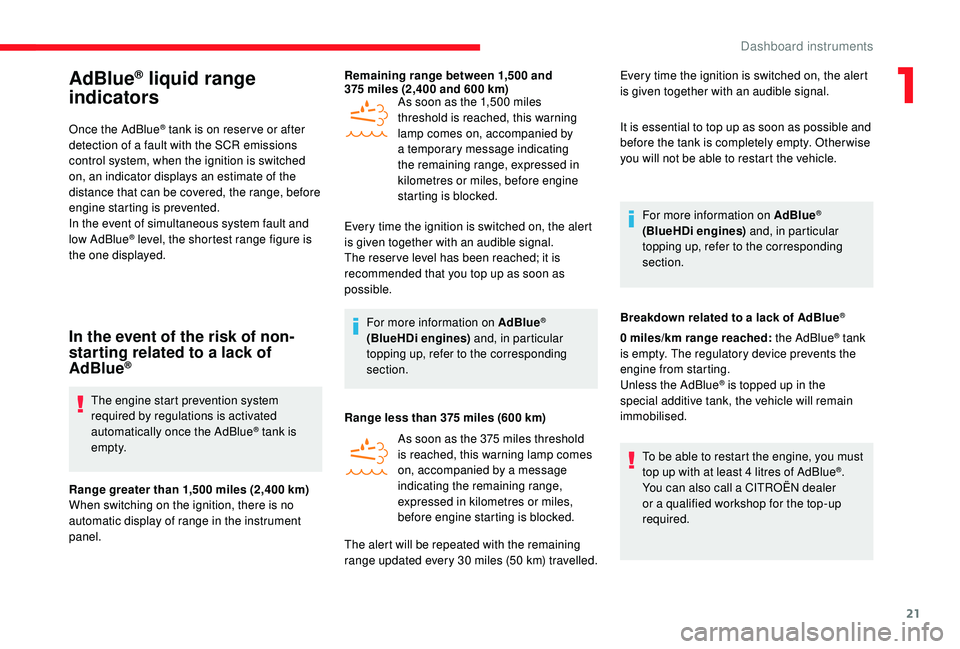
21
AdBlue® liquid range
indicators
Once the AdBlue® tank is on reser ve or after
detection of a
fault with the SCR emissions
control system, when the ignition is switched
on, an indicator displays an estimate of the
distance that can be covered, the range, before
engine starting is prevented.
In the event of simultaneous system fault and
low AdBlue
® level, the shortest range figure is
the one displayed.
In the event of the risk of non-
starting related to a lack of
AdBlue
®
The engine start prevention system
required by regulations is activated
automatically once the AdBlue
® tank is
e m pt y.
Range greater than 1,500
miles (2,400 km)
When switching on the ignition, there is no
automatic display of range in the instrument
panel. Remaining range between 1,500
and
375 miles (2,400 and 600 km)
As soon as the 1,500 miles
threshold is reached, this warning
lamp comes on, accompanied by
a temporary message indicating
the remaining range, expressed in
kilometres or miles, before engine
starting is blocked.
Every time the ignition is switched on, the alert
is given together with an audible signal.
The reser ve level has been reached; it is
recommended that you top up as soon as
possible.
For more information on AdBlue
®
(BlueHDi engines) and, in particular
topping up, refer to the corresponding
section.
Range less than 375
miles (600
km)
As soon as the 375 miles threshold
is reached, this warning lamp comes
on, accompanied by a
message
indicating the remaining range,
expressed in kilometres or miles,
before engine starting is blocked. Every time the ignition is switched on, the alert
is given together with an audible signal.
It is essential to top up as soon as possible and
before the tank is completely empty. Other wise
you will not be able to restart the vehicle.
For more information on AdBlue
®
(BlueHDi engines) and, in particular
topping up, refer to the corresponding
section.
Breakdown related to a
lack of AdBlue
®
0 miles/km range reached: the AdBlue® tank
is empty. The regulatory device prevents the
engine from starting.
Unless the AdBlue
® is topped up in the
special additive tank, the vehicle will remain
immobilised.
To be able to restart the engine, you must
top up with at least 4
litres of AdBlue
®.
You can also call a
CITROËN dealer
or a
qualified workshop for the top-up
required.
The alert will be repeated with the remaining
range updated every 30 miles (50 km) travelled.
1
Dashboard instruments
Page 24 of 232
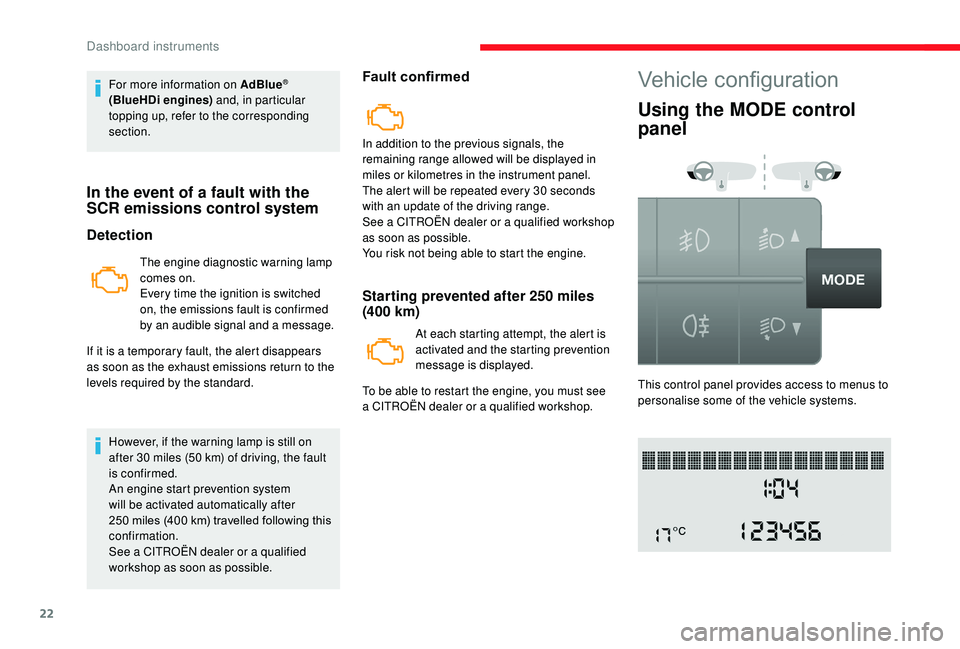
22
For more information on AdBlue®
(BlueHDi engines) and, in particular
topping up, refer to the corresponding
section.
In the event of a fault with the
S CR emissions control system
Detection
The engine diagnostic warning lamp
comes on.
Every time the ignition is switched
on, the emissions fault is confirmed
by an audible signal and a
message.
If it is a
temporary fault, the alert disappears
as soon as the exhaust emissions return to the
levels required by the standard.
However, if the warning lamp is still on
after 30
miles (50 km) of driving, the fault
is confirmed.
An engine start prevention system
will be activated automatically after
250
miles (400 km) travelled following this
confirmation.
See a
CITROËN dealer or a qualified
workshop as soon as possible.
Fault confirmed
In addition to the previous signals, the
remaining range allowed will be displayed in
miles or kilometres in the instrument panel.
The alert will be repeated every 30
seconds
with an update of the driving range.
See a
CITROËN dealer or a qualified workshop
as soon as possible.
You risk not being able to start the engine.
Starting prevented after 250 miles
( 400 km)
At each starting attempt, the alert is
activated and the starting prevention
message is displayed.
To be able to restart the engine, you must see
a
CITROËN dealer or a qualified workshop.
Vehicle configuration
Using the MODE control
panel
This control panel provides access to menus to
personalise some of the vehicle systems.
Dashboard instruments
Page 32 of 232
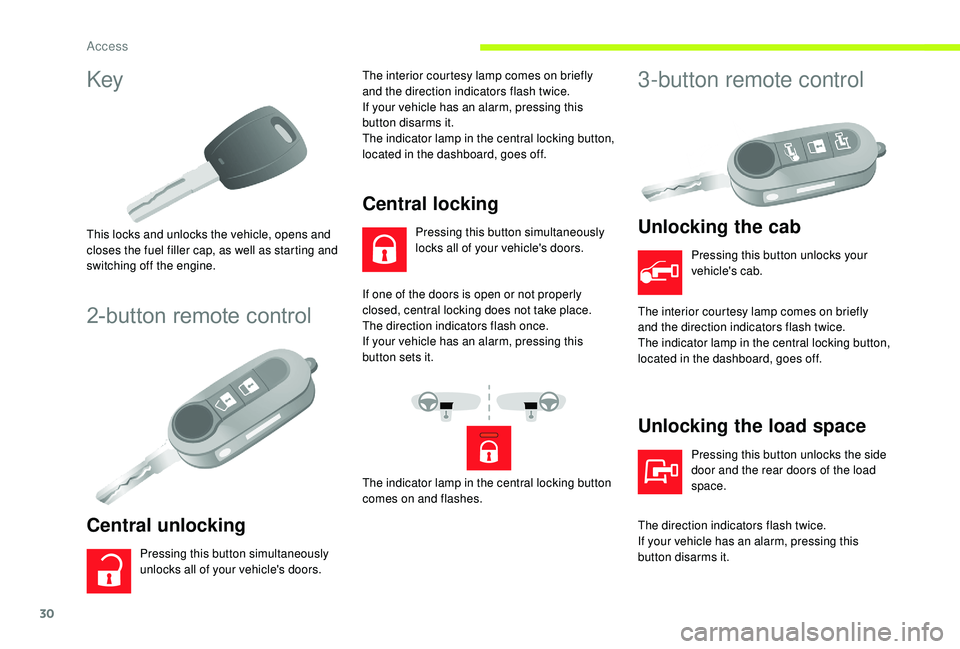
30
Key
This locks and unlocks the vehicle, opens and
closes the fuel filler cap, as well as starting and
switching off the engine.
2-button remote control
Central unlocking
Pressing this button simultaneously
unlocks all of your vehicle's doors.The interior courtesy lamp comes on briefly
and the direction indicators flash twice.
If your vehicle has an alarm, pressing this
button disarms it.
The indicator lamp in the central locking button,
located in the dashboard, goes off.
Central locking
Pressing this button simultaneously
locks all of your vehicle's doors.
If one of the doors is open or not properly
closed, central locking does not take place.
The direction indicators flash once.
If your vehicle has an alarm, pressing this
button sets it.
The indicator lamp in the central locking button
comes on and flashes.
3-button remote control
Unlocking the cab
Pressing this button unlocks your
vehicle's cab.
The interior courtesy lamp comes on briefly
and the direction indicators flash twice.
The indicator lamp in the central locking button,
located in the dashboard, goes off.
Unlocking the load space
Pressing this button unlocks the side
door and the rear doors of the load
space.
The direction indicators flash twice.
If your vehicle has an alarm, pressing this
button disarms it.
Access
Page 34 of 232
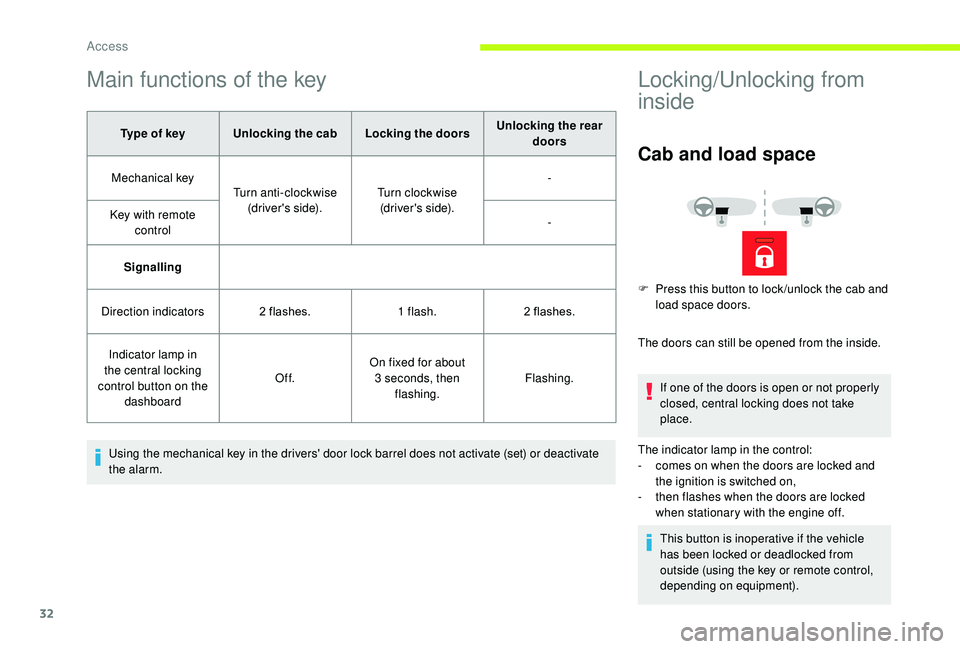
32
Main functions of the key
Type of keyUnlocking the cab Locking the doorsUnlocking the rear
doors
Mechanical key Turn anti-clockwise
(driver's side). Turn clockwise
(driver's side). -
Key with remote control -
Signalling
Direction indicators 2
flashes.1
flash.2
flashes.
Indicator lamp in
the central locking
control button on the dashboard Of f.
On fixed for about
3
seconds, then flashing. Flashing.
Using the mechanical key in the drivers' door lock barrel does not activate (set) or deactivate
the alarm.
Locking/Unlocking from
inside
Cab and load space
The doors can still be opened from the inside. If one of the doors is open or not properly
closed, central locking does not take
place.
The indicator lamp in the control:
-
c
omes on when the doors are locked and
the ignition is switched on,
-
t
hen flashes when the doors are locked
when stationary with the engine off.
This button is inoperative if the vehicle
has been locked or deadlocked from
outside (using the key or remote control,
depending on equipment).
F
P
ress this button to lock /unlock the cab and
load space doors.
Access
Page 38 of 232

36
Deactivation using the
remote control
F Press this button.
Deactivation of the anti-tilt
protection
F Press this control to deactivate the protection (when towing the
vehicle with the alarm on, for
example).
Failure of the remote
control
F Unlock the doors by using the key in the door lock; the alarm is triggered.
F
S
witch on the ignition, recognition of the key
code stops the alarm.
Deactivation occurs when the vehicle is
unlocked.
(Depending on engine).
The protection remains active until the doors
are unlocked with the central locking.
Locking the doors using the key in the
door lock does not set the alarm. To deactivate the siren quickly
following a
false alarm:
F
s
witch on the ignition, recognition of
the key code stops the alarm,
F
p
ress the unlocking button (cab and
key) on the remote control.
To avoid setting the alarm, when washing
the vehicle for example, lock the vehicle
using the key.
Unlocking the vehicle using the remote
control deactivates the siren automatically.
Electric windows
A. Driver's window control
B. Passenger's window control
Manual operation
F To open or close the window, press or pull
switch A/B gently, without passing the
resistance point. The window stops as soon
as the switch is released.
Automatic operation
F To open or close the window, press or pull the control A fully, beyond the resistance
point: the window opens or closes
completely when the switch is released.
Pressing the switch again stops the
movement of the window.
Always remove the key from the ignition
when leaving the vehicle, even for a
short
time.
If an obstacle is encountered during
operation of the electric windows, you must
reverse the movement of the window. To do
this, press the window control concerned.
When the driver operates the passenger
electric windows, they must ensure that
no-one is preventing correct closing of the
windows.
The driver must ensure that the passengers
use the electric windows correctly.
Be particularly aware of children when
operating the windows.
Access
Page 45 of 232
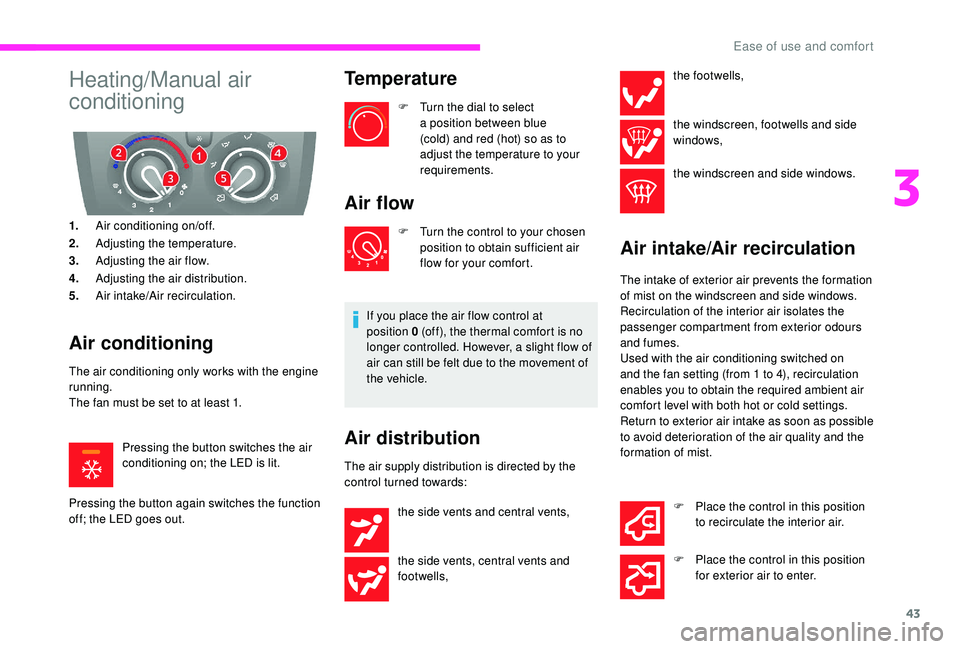
43
Heating/Manual air
conditioning
1.Air conditioning on/off.
2. Adjusting the temperature.
3. Adjusting the air flow.
4. Adjusting the air distribution.
5. Air intake/Air recirculation.
Air conditioning
The air conditioning only works with the engine
running.
The fan must be set to at least 1.
Pressing the button switches the air
conditioning on; the LED is lit.
Pressing the button again switches the function
off; the LED goes out.
Temperature
F Turn the dial to select a position between blue
(cold) and red (hot) so as to
adjust the temperature to your
requirements.
Air flow
F Turn the control to your chosen position to obtain sufficient air
flow for your comfort.
If you place the air flow control at
position 0 (off), the thermal comfort is no
longer controlled. However, a slight flow of
air can still be felt due to the movement of
the vehicle.
Air distribution
The air supply distribution is directed by the
control turned towards: the footwells,
the windscreen, footwells and side
windows,
the windscreen and side windows.
Air intake/Air recirculation
The intake of exterior air prevents the formation
of mist on the windscreen and side windows.
Recirculation of the interior air isolates the
passenger compartment from exterior odours
and fumes.
Used with the air conditioning switched on
and the fan setting (from 1
to 4), recirculation
enables you to obtain the required ambient air
comfort level with both hot or cold settings.
Return to exterior air intake as soon as possible
to avoid deterioration of the air quality and the
formation of mist.
the side vents and central vents,
the side vents, central vents and
footwells, F
P
lace the control in this position
to recirculate the interior air.
F
P
lace the control in this position
for exterior air to enter.
3
Ease of use and comfort
Page 48 of 232
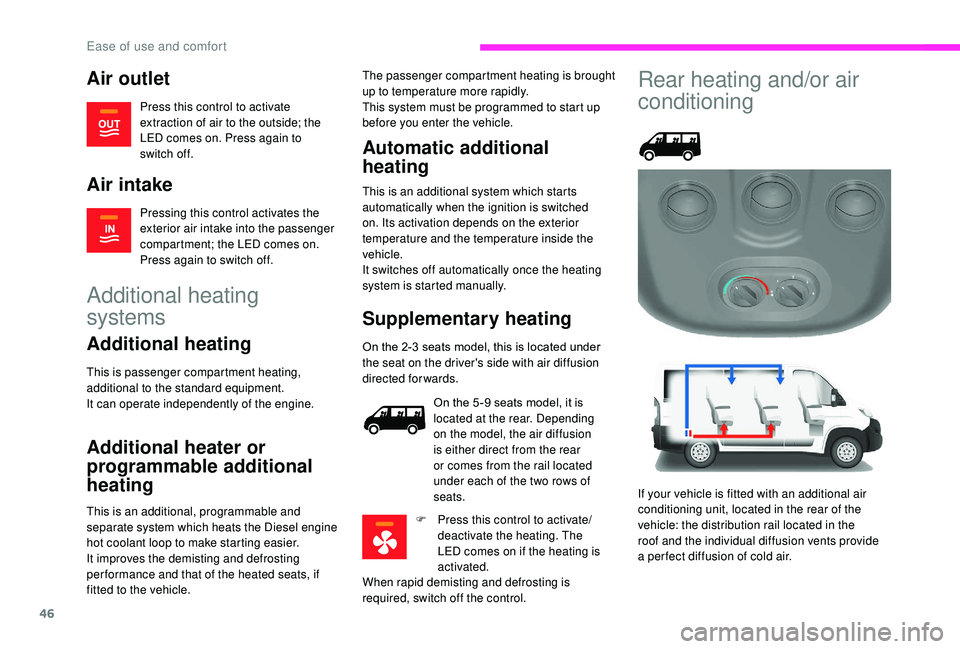
46
Air outlet
Press this control to activate
extraction of air to the outside; the
LED comes on. Press again to
switch off.
Air intake
Pressing this control activates the
exterior air intake into the passenger
compartment; the LED comes on.
Press again to switch off.
Additional heating
systems
Additional heating
This is passenger compartment heating,
additional to the standard equipment.
It can operate independently of the engine.
Additional heater or
programmable additional
heating
This is an additional, programmable and
separate system which heats the Diesel engine
hot coolant loop to make starting easier.
It improves the demisting and defrosting
per formance and that of the heated seats, if
fitted to the vehicle.
Automatic additional
heating
This is an additional system which starts
automatically when the ignition is switched
on. Its activation depends on the exterior
temperature and the temperature inside the
vehicle.
It switches off automatically once the heating
system is started manually. The passenger compartment heating is brought
up to temperature more rapidly.
This system must be programmed to start up
before you enter the vehicle.
Supplementary heating
On the 2-3 seats model, this is located under
t he seat on the driver's side with air diffusion
directed forwards.
On the 5 -9
seats model, it is
located at the rear. Depending
on the model, the air diffusion
is either direct from the rear
or comes from the rail located
under each of the two rows of
seats.
F
P
ress this control to activate/
deactivate the heating. The
LED comes on if the heating is
activated.
When rapid demisting and defrosting is
required, switch off the control.
Rear heating and/or air
conditioning
If your vehicle is fitted with an additional air
conditioning unit, located in the rear of the
vehicle: the distribution rail located in the
roof and the individual diffusion vents provide
a
per fect diffusion of cold air.
Ease of use and comfort
Page 49 of 232
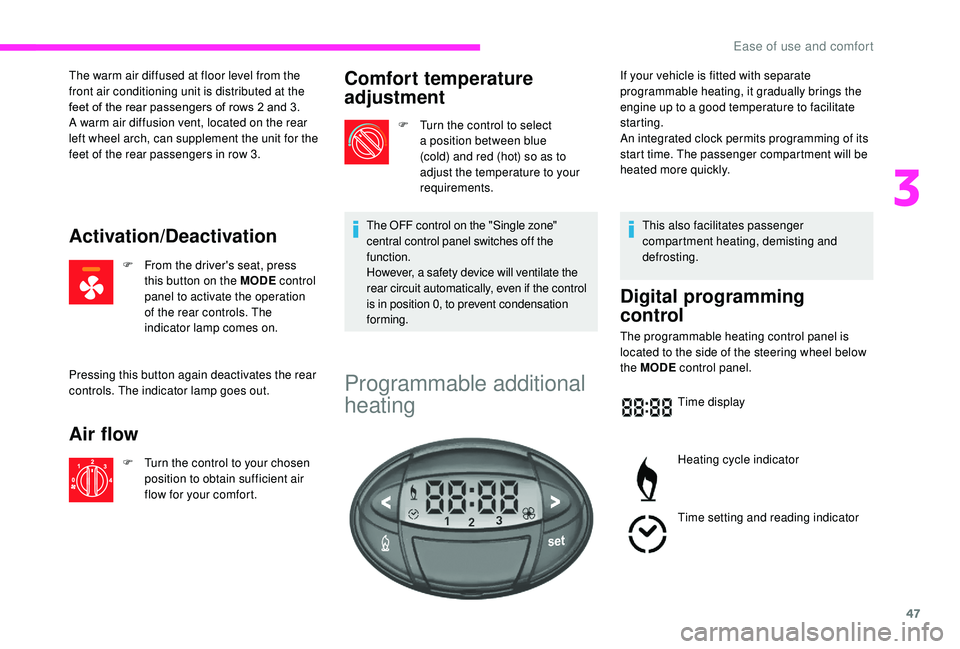
47
The warm air diffused at floor level from the
front air conditioning unit is distributed at the
feet of the rear passengers of rows 2 and 3.
A warm air diffusion vent, located on the rear
left wheel arch, can supplement the unit for the
feet of the rear passengers in row 3.
Activation/Deactivation
F From the driver's seat, press this button on the MODE control
panel to activate the operation
of the rear controls. The
indicator lamp comes on.
Air flow
F Turn the control to your chosen position to obtain sufficient air
flow for your comfort.
Comfort temperature
adjustment
F Turn the control to select a position between blue
(cold) and red (hot) so as to
adjust the temperature to your
requirements.
The OFF control on the "Single zone"
central control panel switches off the
function.
However, a safety device will ventilate the
rear circuit automatically, even if the control
is in position 0, to prevent condensation
forming.
Pressing this button again deactivates the rear
controls. The indicator lamp goes out.
Programmable additional
heating
This also facilitates passenger
compartment heating, demisting and
defrosting.
Digital programming
control
The programmable heating control panel is
located to the side of the steering wheel below
the MODE control panel.
Time display
Heating cycle indicator
Time setting and reading indicator
If your vehicle is fitted with separate
programmable heating, it gradually brings the
engine up to a
good temperature to facilitate
starting.
An integrated clock permits programming of its
start time. The passenger compartment will be
heated more quickly.
3
Ease of use and comfort